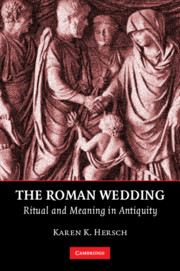4 - Gods of the Roman Wedding
Published online by Cambridge University Press: 05 June 2012
Summary
RITUAL AND RELIGION
The Roman wedding comprised a collection of ritual acts: the gods' will may have been sought before the bride left her home; the bride, adorned in protective garb that she may have shared with priestesses in Rome, was led accompanied by music and singing to her husband's house; she performed small sacrifices to the guardian spirits of her natal home, her community, and her new abode; and, finally, she may have pronounced her consent to the marriage with a formula (perhaps less religious than legal or “customary”). At the same time, she was co-opted in to the new home by fire and water, symbolizing the sustaining of life. One scholar of Roman religion has noted that “religion consists normally…in ritual action that takes place in groups”; because the defining events of the wedding were rituals performed before the community, then we may look on the wedding as a religious act.
Evidence from legal, literary, and artistic sources suggests that the core event, or central ritual, of the Roman wedding was the procession of a woman, the bride, to her new home. A Roman woman was duly married, the sources suggested, if she had been viewed by the community in her wedding garb. Thus, for example, Apuleius was obliged to prove his good intentions when he married his wife, Pudentilla, far from prying eyes; he made it clear that these eyes were needed to give the wedding its legitimacy.
- Type
- Chapter
- Information
- The Roman WeddingRitual and Meaning in Antiquity, pp. 227 - 288Publisher: Cambridge University PressPrint publication year: 2010

